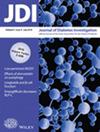Clustering-based risk stratification of prediabetes populations: Insights from the Taiwan and UK Biobanks
Abstract
Aims/Introduction
This study aimed to identify low- and high-risk diabetes groups within prediabetes populations using data from the Taiwan Biobank (TWB) and UK Biobank (UKB) through a clustering-based Unsupervised Learning (UL) approach, to inform targeted type 2 diabetes (T2D) interventions.
Materials and Methods
Data from TWB and UKB, comprising clinical and genetic information, were analyzed. Prediabetes was defined by glucose thresholds, and incident T2D was identified through follow-up data. K-means clustering was performed on prediabetes participants using significant features determined through logistic regression and LASSO. Cluster stability was assessed using mean Jaccard similarity, silhouette score, and the elbow method.
Results
We identified two stable clusters representing high- and low-risk diabetes groups in both biobanks. The high-risk clusters showed higher diabetes incidence, with 15.7% in TWB and 13.0% in UKB, compared to 7.3% and 9.1% in the low-risk clusters, respectively. Notably, males were predominant in the high-risk groups, constituting 76.6% in TWB and 52.7% in UKB. In TWB, the high-risk group also exhibited significantly higher BMI, fasting glucose, and triglycerides, while UKB showed marginal significance in BMI and other metabolic indicators. Current smoking was significantly associated with increased diabetes risk in the TWB high-risk group (P < 0.001). Kaplan–Meier curves indicated significant differences in diabetes complication incidences between clusters.
Conclusions
UL effectively identified risk-specific groups within prediabetes populations, with high-risk groups strongly associated male gender, higher BMI, smoking, and metabolic markers. Tailored preventive strategies, particularly for young males in Taiwan, are crucial to reducing T2D risk.


 求助内容:
求助内容: 应助结果提醒方式:
应助结果提醒方式:


